
The Charolais or Charolaise is a French breed of taurine beef cattle. It originates in, and is named for, the Charolais area surrounding Charolles, in the Saône-et-Loire department, in the Bourgogne-Franche-Comté region of eastern France.
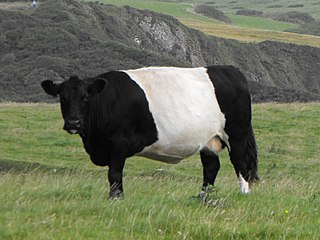
The Lakenvelder is a Dutch and German breed of dairy cattle. It is reported from the Netherlands and Belgium, but may be extinct in Germany.

The Brangus is an American hybrid breed of beef cattle derived from cross-breeding of American Angus and Brahman stock. Registered animals have 5/8 Angus and 3/8 Brahman parentage. A similar hybrid breed, the Australian Brangus, was separately developed in Australia from about 1950.
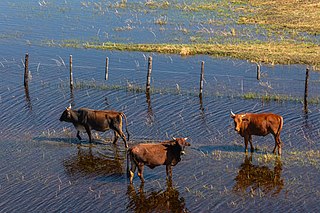
The Tswana is an indigenous breed or group of breeds of beef cattle of Botswana. It is a Sanga type, similar to Barotse and Tuli. The coat colour may be solid red or black, red pied or – less frequently – black pied. It is also present in South Africa. Animals of this breed are well adapted to hot, dry environments and have a high level of tick and heat tolerance.
The Indu-Brasil or Indo-Brazilian is a Brazilian breed of zebuine beef cattle. It was bred in the early twentieth century in the Triângulo Mineiro in the western part of Minas Gerais state, and particularly in the area surrounding Uberaba. It was originally known as the Induberaba. It derives from imported Indian zebuine cattle, principally Gir and Kankrej. It was formerly an important beef breed, but in the twenty-first century is an endangered breed. It is characterised by particularly large ears, perhaps the largest seen in any breed of cattle.

The Pinzgauer is a breed of domestic cattle from the Pinzgau region of the federal state of Salzburg in Austria. It has distinctive colouring, with chestnut-brown sides and white back and underside. It was in the past a triple-purpose breed, raised for meat, milk and draught use. There is a naturally polled sub-type, the Jochberg Hummel. In 2007 the breed was not considered by the FAO to be at risk.

Kalmyk cattle is a breed of beef cattle of the former Soviet Union, now found in the Russian Federation, in Kazakhstan and in Tajikistan. It is believed to have originated in Dzungaria, and to have been brought into south-eastern Russia by migrating Kalmyks in the seventeenth century.

The Ringamålako is an endangered Swedish breed of dairy cattle. It is named for the village of Ringamåla in the southern Swedish county of Blekinge, and is found primarily in southern Sweden. It is similar to the type of Swedish Red-and-White cattle of the 1940s, and is considered a valuable genetic resource.
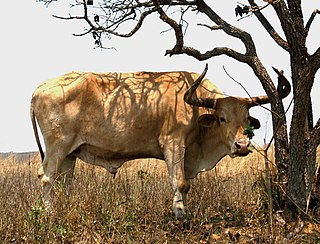
The Caracu is a Brazilian breed of beef cattle. It is a Criollo breed, derived from European cattle brought to Brazil by the conquistadors; it has little or no zebuine influence. It was originally a triple-purpose breed, used for draught work and transport, for meat and for milk; in the twenty-first century it is reared principally for beef, but there are also dairy lines. It has contributed to the development of a number of other breeds, among them the Caldeano. It is closely similar to the Mocho Nacional, a polled breed, and it is probable that the two will be merged.
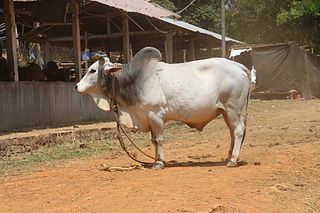
The Malvi or Malavi, also known as Manthani or Mahadeopuri, is breed of zebu cattle from the Malwa plateau in western Madhya Pradesh, in central India. It is a good draught breed; the milk yield of the cows is low.

The Rubia Gallega, Galician: Rubia Galega, is a breed of cattle native to the autonomous community of Galicia in north-western Spain. It is raised mainly for meat. It is distributed throughout Galicia, with about 75% of the population concentrated in the province of Lugo. The coat may be red-blond, wheaten, or cinnamon-coloured.

The Mertolenga is a Portuguese breed of cattle. It is named for the concelho of Mértola in south-eastern Alentejo, bordering with Spain. In 2003 it was one of thirteen registered Portuguese cattle breeds, constituting approximately 19 per cent of cattle in the country.

The Minhota or Galega is a Portuguese breed of cattle. It is reared principally for beef; in the past it was used also as a draught beast and for milk.

The Mirandesa is a Portuguese breed of beef cattle. It originates in – and is named for – the Terra de Miranda, the area of north-eastern Portugal where Mirandese is spoken, particularly the municipality of Miranda do Douro. It was formerly used as a draught animal, and was distributed throughout almost all of the country. It is now reared for beef; the meat may be marketed as Denominação de Origem Controlada.

The Swedish Red-and-White, Swedish: Svensk Röd och Vit Boskap, frequently abbreviated to SRB, is a Swedish breed of dairy cattle. It was created in the 1920s by crossing the Swedish Red Pied and Swedish Ayrshire breeds.
The Swedish Red Pied, Swedish: Rödbrokig Svensk Boskap, frequently abbreviated to RSB, was a Swedish breed of dairy cattle. It is now considered extinct. It was merged in the 1920s with the Swedish Ayrshire breed to create the Swedish Red-and-White, which is one of the principal dairy breeds of Sweden.

The Swedish Polled, Swedish: Svensk Kullig Boskap, often abbreviated to SKB, is a Swedish breed of domestic cattle. It was created in 1937 from two different Swedish cattle breeds, the Swedish Red Polled and the Fjäll. Breeders did not accept the new classification, and continued to maintain separate bloodlines as before. Of the two constituent breeds, the Swedish Red Polled received official recognition in 2004, while the Fjäll has divided into two sub-breeds, the Fjällnära Boskap and the Svensk Fjällras.
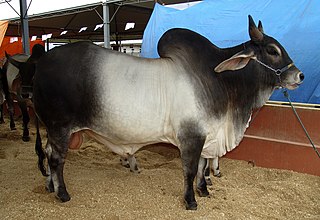
The Guzerá or Guzerat is a Brazilian breed of domestic cattle. It derives from cross-breeding of Indian Kankrej cattle, imported to Brazil from 1870 onwards, with local taurine Crioulo cattle of European origin. The name is a Portuguese spelling of that of the western Indian state of Gujarat.

The Red Brangus is an American breed of hybrid beef cattle, with both taurine and indicine genetic heritage. Development began in Texas in the 1940s. It is a colour variant of the Brangus, a hybrid of American Angus and Brahman cattle, and differs from it only in colour. There are two herd-books, one international and one American. For international registration the animal must be of 5/8 Angus and 3/8 Brahman descent; in the United States, it may be any mix of the two breeds, but registration is conditional on inspection.























